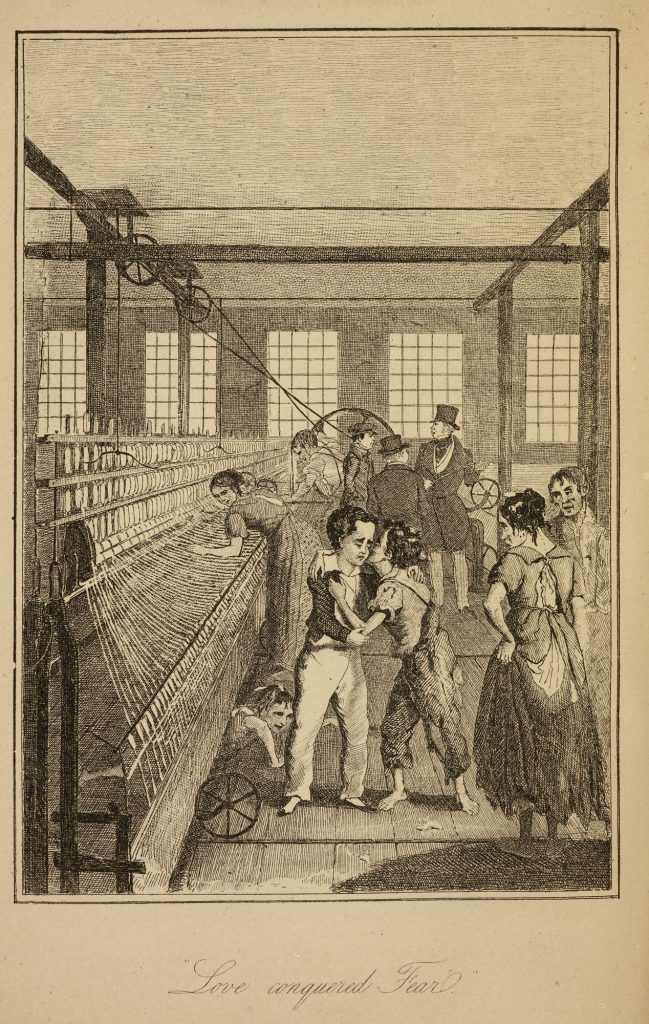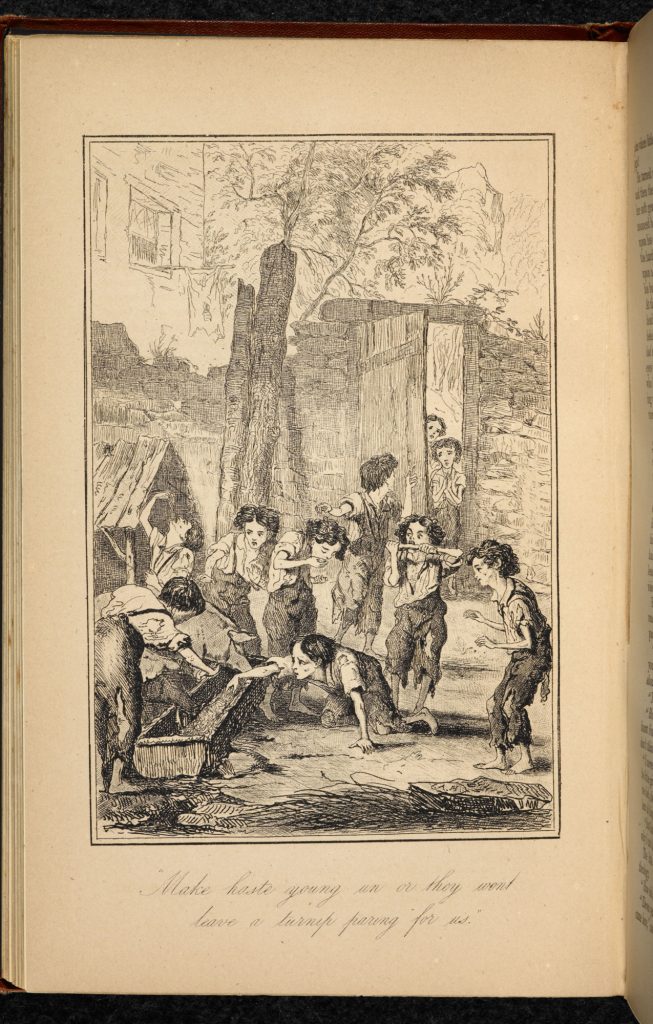The industrial revolution is one of the most impactful events in the history of the last 200 years. The use of new technology and new organization of labor in the factory system transformed the European economy and, dovetailing with European Imperialism, transformed the relationship between Europe and the rest of the world with far-reaching political, social, and cultural effects. This transformation took over 100 years, however, and living through it, especially for the workers, was difficult. The following sources, including contemporary reports and images, offer us a glimpse into the social impact of this transformation in Britain.
Excerpt from The Manufacturing Population of England by P. Gaskell
The vast deterioration in personal form which has been brought about in the manufacturing population, during the last thirty years, a period not extending over one generation, is singularly impressive, and fills the mind with contemplations of a very painful character. If hardship – if low wages – if an impossibility of acquiring the means to secure the necessaries of life, or of clothing fit for protection against the influences of a variable climate – if one or all of these causes had been in operation, their effects might have been predicted.
If war had swept its devastating and demoralizing wing over the land – if famine or pestilence had prevailed, the change which has been wrought might have been looked for, and its existence would have excited no surprise. But nothing of this sort has been in operation. On the contrary, with the exception of one particular class (hand-loom weavers) wages have been and are good, more than amply sufficient to supply all that is wanted even for liberal support. No ‘foreign levy ‘ or intestine commotion, save partial outbreaks of popular violence, brought about by themselves, have influenced their condition; no famine or plague has occurred to break up the bonds of society; no retrograde movement has been made to benighted ignorance, but intelligence has been becoming day after day more and more widely diffused; and yet there is a numerous population, forming a most important branch, an integral portion of the kingdom, an essential, an indispensable agent in supporting its prosperity, exhibiting in all its features an approximation to the shapes and growths of the lowest barbarism.
Any man who has stood at twelve o’clock at the single narrow doorway, which serves as the place of exit for the hands employed in the great cotton mills, must acknowledge, that an uglier set of men and women, of boys and girls, taken them in the mass, it would be impossible to congregate in a smaller compass. Their complexion is sallow and pallid with a peculiar flatness of feature, caused by the want of a proper quantity of adipose substance to cushion out the cheeks. Their stature low – the average height of four hundred men, measured at different times, and different places, being five feet six inches. Their limbs slender, and playing badly and ungracefully. A very general bowing of the legs. Great numbers of girls and women walking lamely or awkwardly, with raised chests and spinal flexures. Nearly all have flat feet, accompanied with a down tread, differing very widely from the elasticity of action in the foot and ankle, attendant upon perfect formation. Hair thin and straight many of the men having but little beard, and that in patches of a few hairs, much resembling its growth among the red men of America. A spiritless and dejected air, a sprawling and wide action of the legs, and an appearance, taken as a whole, giving the world but ” little assurance of a man,” or if so, ” most sadly cheated of his fair proportions.” Beauty of face and form are both lost in angularity, while the flesh is soft and flabby to the touch, yielding no ” living rebound” beneath the finger. The hurry and anxiety of this juncture brings out very strongly all their manifold imperfections.
The life and adventures of Michael Armstrong, the factory boy by Frances Trollope
Industrialization led to an increase in the use of child labor, and a change in the nature of that labor. Children had always been employed on farms and in family businesses, but rarely for such long hours and in such dangerous conditions. Contemporary unease with this fact led to a series of Parliamentary inquiries into working conditions in mines and factories, particularly for children. Their reports influenced several contemporary authors, including Charles Dikens, who featured child workers in several of his novels, and Frances Trollope, who wrote The Life and Adventures of Michael Armstrong, the Factory Boy. The novel was an early work of social commentary, originally published as a weekly serial. The following two images illustrated this story, presenting a picture of the horrors of factory life for children.


Excerpts from The Condition and Treatment of the Children employed in the Mines and Collieries of the United Kingdom

In the neighborhood of Halifax, Mr. Scriven thus describes the kind of place in which children are employed, at ages, be it remembered, when the law deems them too young to endure the confinement of factors – namely, at six, seven, and eight years old.
“In the Booth Town Pit, in which Patiences Kershaw hurried eleven corves a day, a walked, crept, and rode 1800s years, to one of the nearest ‘faces;’ the most distant was 200 further; the bottom or floor of this gate was every here and there three or four inches deep in water, and muddy throughout. The Swan Bank Pit, to which I was accompanied by Dr. Smith and Mr. Saunders, as almost as bad, and more resembled a city drain than anything else. In some of them I have had to creep upon my hands and knees the whole distance, the height being barely twenty inches, and then have gone still lower, upon my breast, and crawled like a turtle to get up to the headings.”
Fanny Drake, on of Mr. Symons’ witnesses, aged fifteen, who worked at Charelsworths Woot Pit, near Wakefield, thus describes the condition of the place of work:
“It has been a very wet pit before the engine was put up. I have had to hurry up to the calves of my legs in water. It was as bad as this a fortnight at a time; and this was for half a year last winter. My feet were skinned, and just as if they were scalded; for the water was bad – it had stood some time, and I was off my work owing to it, and had a headache and bleeding at my nose.”
Many of the mines in Lancashire are very wet. In some I visited, the water pours out of the roof to such a degree, that persons descending are completely wet through by it. George Brown, at Messrs. Broom and Hulley’s gives the following description of the mines in the neighborhood of Rainow:
“The small mines in the neighborhood of Rainow are nearly all exceedingly wet; I have worked there when half my body has been under water, and we have one man working in the deep level, who works constantly in water half way up his sides. The seams there are only fourteen inches thick, so that the pickmen are obliged to lie on their sides.”
” I wish,” says the sub-commisiioner,” to call the attention of the Board to the pits about Brampton. The pits are altogether worked by boys; the elder one lies on his side, and in that posture doles and gets the coal; it is then loaded in a barrow or tub, and drawn along the bank of the pit-mouth without wheels, by moys from eight to twelve years of age, on all-fours, with a dog belt and chain, the passages being very often an inch or two thick in black mud, and are neither ironed nor wooded (J.M. Fellows, Ewq., App. part II., p. 254)
Questions for Discussion
- What is P. Gaskell’s tone in the first selection and why do you think he was so concerned with physical appearance? What does physical appearance seem to indicated to him about the effect factories were having on the laborers?
- Look carefully at the images from The Life and Adventures of Michael Armstrong. What emotions are the images meant to bring forth from the reader? Why were illustrations and fictionalized narratives like this helpful to those who wanted to bring about change in the conditions of the working class, especially working class children?
- In the third selection, what issues about working conditions in mines or collieries are revealed? What might be the danger of such conditions to the health and safety of the workers?
Additional Resources
“The Industrial Revolution” by Matthew White, British Library, https://www.bl.uk/georgian-britain/articles/the-industrial-revolution
“Newspaper report of fatal accident at the Great Western Cotton Works,” British Library, https://www.bl.uk/collection-items/newspaper-report-of-fatal-accident-at-the-great-western-cotton-works
“1833 Factory Act,” The National Archives UK, https://www.nationalarchives.gov.uk/education/resources/1833-factory-act/
